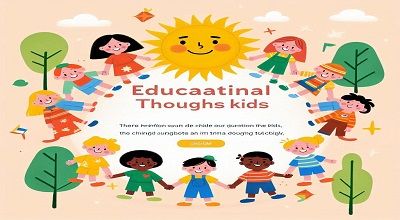Educational Thoughts for Kids
Latest Educational Thoughts for Kids here. Fostering a positive and engaging learning environment for kids is crucial for their intellectual and emotional development. Here are some educational thoughts and approaches for kids:
Make Learning Fun
- Integrate play into learning activities.
- Use games, puzzles, and interactive activities to teach concepts.
Encourage Curiosity
- Support and answer their questions.
- Explore topics they show interest in, even if it’s outside the traditional curriculum.
Promote Critical Thinking
- Encourage problem-solving and decision-making.
- Teach them to analyze situations and think independently.
Connect Learning to Real Life
- Relate lessons to everyday experiences.
- Take field trips or use real-world examples to illustrate concepts.
Emphasize Creativity
- Allow for creative expression through art, writing, and imaginative play.
- Value different perspectives and ideas.
Build a Love for Reading
- Read with them regularly.
- Provide a variety of books that cater to different interests and reading levels.
Teach Lifelong Learning
- Instill the idea that learning is a continuous process.
- Model a growth mindset by embracing challenges and learning from mistakes.
Incorporate Technology Wisely
- Use educational apps and websites to supplement learning.
- Set limits on screen time and ensure a balance with other activities.
Cultivate a Positive Learning Environment
- Create a comfortable and organized study space.
- Encourage open communication and a supportive atmosphere.
Promote Social Skills
- Foster collaboration and teamwork.
- Teach empathy, respect, and effective communication.
Celebrate Achievements
- Acknowledge their efforts and accomplishments.
- Encourage a sense of pride in their learning journey.
Adapt to Individual Learning Styles
- Recognize that each child learns differently.
- Tailor teaching methods to suit their strengths and preferences.
Encourage Goal Setting
- Help them set realistic and achievable goals.
- Break down larger objectives into smaller, manageable tasks.
Instill Time Management
- Teach the importance of prioritizing tasks and managing time effectively.
- Foster a sense of responsibility for their own learning.
Promote Cultural Awareness
- Introduce them to a diverse range of cultures and perspectives.
- Encourage respect for diversity and understanding of different backgrounds.
Summary
Remember that every child is unique, so these thoughts can be adapted to fit individual needs and preferences. The key is to create an environment that nurtures a love for learning and helps children develop the skills they need to succeed in various aspects of life.
